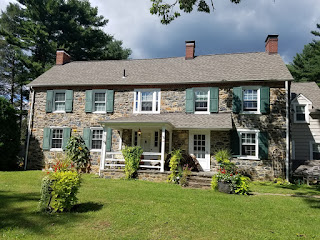 |
| The David Graves House |
Longtime readers of this blog may know that something I find fascinating is the phenomenon of historic houses hidden back in the midst of newer, suburban subdivisions. As the farms of the 18th and 19th Centuries were sold off to make way for the housing developments of the 20th, the fates of the old farmhouses were really up in the air. Many were torn down to make way for the new, but some, if they were in good enough shape (and/or still owned by the farming family), were spared the wrecking ball. I'm grateful to the owners and developers who kept these old homes around, because many have rich histories and connections to the founding families of Mill Creek Hundred.
One such house can be found on Carillon Drive in Brandywine Springs Manor, off of Faulkland Road across from Brandywine Springs Park. This is the David Graves House, and it and its surrounding property have stories that trace back to the earliest days of Mill Creek Hundred, with some interesting personalities along the way. The field stone house that stands today certainly dates back to at least the mid-1800's, and there's reason to believe that part of it may be much older than that. Thanks in large part to the tireless work of Walt Chiquoine, the history of the ownership of the property is pretty well-understood. It certainly sits in an interesting corner of MCH.
The first European settler on what would become the Graves farm was a Scots-Irish immigrant named Bryan McDonald. In 1689, he was given a warrant for 239 acres by William Penn, followed in 1703 by two more for 154 and 200 acres. All three properties were surveyed in 1705 and a patent issued in 1706 for a total of 593 acres. As the figure below shows, the tracts were centered around what's now the Faulkland Road/Newport Gap Pike intersection. As you can also see, the site of the Graves House is located in McDonald's original 1689 parcel. Considering that the house sits along a ridge of high ground overlooking the surrounding area, there's good reason to think that McDonald's original homestead site may have been very close to the current house.
One such house can be found on Carillon Drive in Brandywine Springs Manor, off of Faulkland Road across from Brandywine Springs Park. This is the David Graves House, and it and its surrounding property have stories that trace back to the earliest days of Mill Creek Hundred, with some interesting personalities along the way. The field stone house that stands today certainly dates back to at least the mid-1800's, and there's reason to believe that part of it may be much older than that. Thanks in large part to the tireless work of Walt Chiquoine, the history of the ownership of the property is pretty well-understood. It certainly sits in an interesting corner of MCH.
The first European settler on what would become the Graves farm was a Scots-Irish immigrant named Bryan McDonald. In 1689, he was given a warrant for 239 acres by William Penn, followed in 1703 by two more for 154 and 200 acres. All three properties were surveyed in 1705 and a patent issued in 1706 for a total of 593 acres. As the figure below shows, the tracts were centered around what's now the Faulkland Road/Newport Gap Pike intersection. As you can also see, the site of the Graves House is located in McDonald's original 1689 parcel. Considering that the house sits along a ridge of high ground overlooking the surrounding area, there's good reason to think that McDonald's original homestead site may have been very close to the current house.
